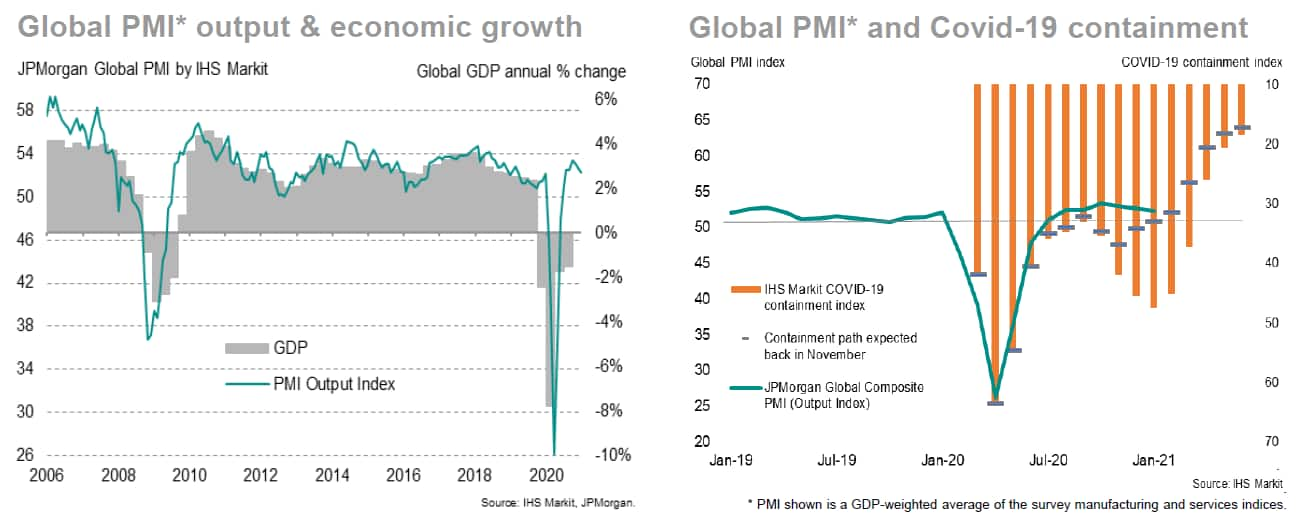Customer Logins
Obtain the data you need to make the most informed decisions by accessing our extensive portfolio of information, analytics, and expertise. Sign in to the product or service center of your choice.
Customer Logins
ECONOMICS COMMENTARY
Feb 05, 2021
Global growth slows in January amid new COVID-19 lockdowns and supply constraints
The following is an extract from IHS Markit's monthly PMI overview presentation. For the full report please click on the link at the bottom of the article.
The JPMorgan Global PMI™ (compiled by IHS Markit) edged down for a third successive month in January, dipping from 52.7 in December to 52.3, its lowest since last July but nevertheless still indicating solid annualised GDP growth of approximately 3%.
The weaker reading was in part attributable to rising coronavirus disease 2019 (COVID-19) cases in many countries, which in turn often led to tighter social distancing restrictions. These measures were reported to have not only curbed demand but also stifled supply capacity, the latter exacerbated by restocking and low employment in many companies. However, the adverse impact on global GDP from the pandemic in recent months so far looks considerably less severe than seen during the first half of 2020. This is being corroborated by official GDP data, which for example showed solid gains in the US and China and a smaller than feared contraction in the eurozone.

Chris Williamson, Chief Business Economist, IHS Markit
Tel: +44 207 260 2329
chris.williamson@ihsmarkit.com
© 2021, IHS Markit Inc. All rights reserved. Reproduction in whole
or in part without permission is prohibited.
Purchasing Managers' Index™ (PMI™) data are compiled by IHS Markit for more than 40 economies worldwide. The monthly data are derived from surveys of senior executives at private sector companies, and are available only via subscription. The PMI dataset features a headline number, which indicates the overall health of an economy, and sub-indices, which provide insights into other key economic drivers such as GDP, inflation, exports, capacity utilization, employment and inventories. The PMI data are used by financial and corporate professionals to better understand where economies and markets are headed, and to uncover opportunities.
This article was published by S&P Global Market Intelligence and not by S&P Global Ratings, which is a separately managed division of S&P Global.
{"items" : [
{"name":"share","enabled":true,"desc":"<strong>Share</strong>","mobdesc":"Share","options":[ {"name":"facebook","url":"https://www.facebook.com/sharer.php?u=http%3a%2f%2fwww.spglobal.com%2fmarketintelligence%2fen%2fmi%2fresearch-analysis%2fglobal-growth-slows-in-january-amid-new-covid19-lockdowns-Jan21.html","enabled":true},{"name":"twitter","url":"https://twitter.com/intent/tweet?url=http%3a%2f%2fwww.spglobal.com%2fmarketintelligence%2fen%2fmi%2fresearch-analysis%2fglobal-growth-slows-in-january-amid-new-covid19-lockdowns-Jan21.html&text=Global+growth+slows+in+January+amid+new+COVID-19+lockdowns+and+supply+constraints+%7c+S%26P+Global+","enabled":true},{"name":"linkedin","url":"https://www.linkedin.com/sharing/share-offsite/?url=http%3a%2f%2fwww.spglobal.com%2fmarketintelligence%2fen%2fmi%2fresearch-analysis%2fglobal-growth-slows-in-january-amid-new-covid19-lockdowns-Jan21.html","enabled":true},{"name":"email","url":"?subject=Global growth slows in January amid new COVID-19 lockdowns and supply constraints | S&P Global &body=http%3a%2f%2fwww.spglobal.com%2fmarketintelligence%2fen%2fmi%2fresearch-analysis%2fglobal-growth-slows-in-january-amid-new-covid19-lockdowns-Jan21.html","enabled":true},{"name":"whatsapp","url":"https://api.whatsapp.com/send?text=Global+growth+slows+in+January+amid+new+COVID-19+lockdowns+and+supply+constraints+%7c+S%26P+Global+ http%3a%2f%2fwww.spglobal.com%2fmarketintelligence%2fen%2fmi%2fresearch-analysis%2fglobal-growth-slows-in-january-amid-new-covid19-lockdowns-Jan21.html","enabled":true}]}, {"name":"rtt","enabled":true,"mobdesc":"Top"}
]}




